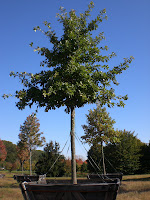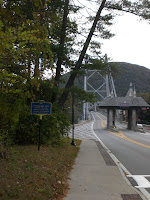Stony Point Light House - Stony Point Battlefield
Stony Point, NY
Stony Point Lighthouse, the oldest on the Hudson, marked the entrance to the Hudson Highlands for nearly a hundred years and was built in 1826, the result of a contract between Thomas Phillips, of New York City, and Jonathan Thompson, Superintendent of Lighthouses. The specifications called for the construction of "an octagonal Pyramid, to be built of blue split stone and the best quick lime and sand mortar" to serve as a beacon for the increased river traffic created by the opening of the Erie Canal the previous year. The building plan stated that the tower was to be twenty feet above the water table and have three stories and a cellar for the storage of whale oil. A wooden stairway would lead from the first floor to the second, and a wooden ladder would connect the second floor with the lantern -- the name given to the glass-enclosed top of the lighthouse. On December 1, the lighthouse, complete with copper roof and ventilator, was finished -- at a cost of $3,350.
Included in the price, Phillips also constructed a "dwelling house," the first of three on the site, for the keeper of the light. The keeper was at his (or her) post year-round and often round-the-clock, especially during hazardous weather conditions, performing the primary duty of making sure that the light was on, and that it was properly maintained. This included keeping the oil containers full and the reflectors or lenses clean, and making sure the fog signal operated during inclement weather.
Originally -- though not at Stony Point -- cannons were fired to guide ships through foggy weather when the light was not visible, but in the 19th century, bells came into use. They were rung by hand until devices were created to ring them mechanically. The Stony Point fog bell was installed in a nearby tower in 1857. In 1876, the fog bell was attached to the lighthouse, and in 1890 was moved by the water's edge to another tower with a white light on top. The bell rang every fifteen seconds in foggy weather using a clockwork type mechanism that had to be wound by hand. When the mechanism failed, the bell still had to be rung, occasionally by sledgehammer.
The keepers of Stony Point Lighthouse -- some eight men and women in all -- performed these tasks with dedication and vigilance, with the result that in the lighthouse's period of operation (1826 - 1925), only one vessel ran aground - the steamer Poughkeepsie in March 1901 - with no loss of life.
Different kinds of fuel were developed over the years. Coal and Tallow were used in early European lighthouses, but oil lamps were used in the United States lighthouse system. Whale oil was the standard fuel for many years, but when its price increased, lard oil gradually replaced it. This fuel was used primarily until 1877, when kerosene became available. By the end of the 19th century, electric lights had begun to supersede the oil lamp system.
Lighting methods varied as well and innovations occurred. In 1781, the Argand lamp, which had a hollow, circular wick, was invented, producing an intense, smokeless flame. Later, parabolic reflectors with highly polished surfaces were used to increase the intensity of the lamp and project it toward the water. The light sources were set at a predetermined distance from the center of the reflector, and the light was intensified and focused into a beam. Multiple lamps were used in order to make the light visible over a wide arc. In 1838, the lighting apparatus at Stony Point was listed as having seven lamps with spherical reflectors, arranged on two horizontal tables.
In 1822, however, Augustin Jean Fresnel, a Frenchman, designed a lens that used a number of beveled glass prisms which collected and focused the light rays from the lamp in a horizontal beam, thus greatly magnifying the light's intensity. The result was a system that made other methods obsolete. Fresnel lenses were classified in orders from one to six, the lowest number being the largest and most powerful. First-order lenses were coastal beacons, and sixth-order lenses generally marked minor harbors or river channels. In 1856, the Stony Point Lighthouse received a fifth-order Fresnel lens, which was replaced by a more powerful fourth-order Fresnel lens in 1902.
Different colored lights were used to facilitate identification. The three standard light colors used were white, red and green. A light station might employ any one of the three colors, or two or more colors combined in a pattern called a characteristic. In almost all cases, white was used for lights indicating land because of greater visibility.
Lights were also designated as fixed or flashing. Originally, the Stony Point light was a fixed white beam, projected at an angle of 270 degrees and visible primarily from the south and east. In 1902, the white light on top of the fog bell tower near the shoreline was changed to red, possibly to avoid confusion with the white light from the lighthouse. The present restored light is operated automatically by solar power and uses a period fourth-order Fresnel lens, which projects a flash of light every four seconds.
In 1925 the original lighthouse was decommissioned and replaced by a steel light tower built near the shoreline. The light tower was manually operated until it was automated by the US Coast Guard in 1973. In 1986, the exterior of the lighthouse was repaired, painted and the lantern re-glazed. On October 7, 1995, the lighthouse, with an exhibit, a restored interior, and a period fourth-order Fresnel lens, was reopened to the public and the light activated for the first time in 70 years.
Visiting the Lighthouse
Through the efforts of the
Stony Point Battlefield State Historic Site, the Palisades Park Interstate Commission, and NYS Office of Parks, Recreation, and Historic Preservation, restoration of the lighthouse began in 1986. The exterior was repaired and painted and the lantern was re-glazed. On October 7, 1995, restoration was complete, and the light was activated for the first time in 70 years. The automatic light, operated by solar power, beams a flash of light once every four seconds.
The lighthouse is open to the public with exhibits, restored interior, and a period fourth-order Fresnel lens. Tours of the lighthouse are available on a regular basis on weekends. Although the lighthouse is relatively short, ascending the steps requires caution as they are extremely steep.Stony Point Battlefield State Historic Site is open April 15 to October 21 on Wednesdays through Saturdays from 10am until 5pm, Sundays from 1pm till 5pm. Also open on Memorial Day, Independence Day and Labor Day.















































